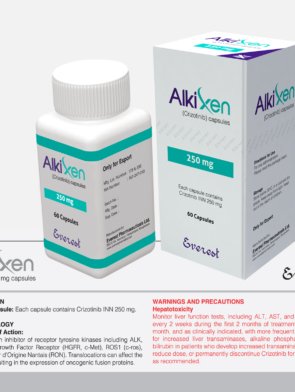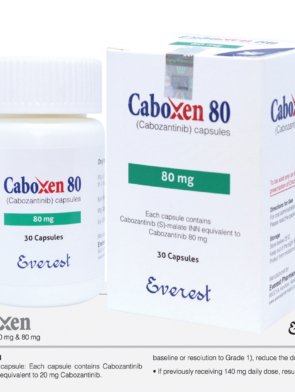Monalast (Montelukast Sodium USP) 10 mg
£0.00
- Prophylaxis and chronic treatment of asthma
- Acute prevention of Exercise-Induced Bronchoconstriction (EIB)
- Relief of symptoms of Allergic Rhinitis (AR): Seasonal & Perennial Allergic Rhinitis
- The dosage for adults and adolescents 15 years of age and older: Monas 10 mg tablet once daily.
- The dosage for pediatric patients 6 to 14 years of age: Monas 5 mg tablet once daily.
- The dosage for pediatric patients 2 years to 5 years of age: Monas 4 mg tablet once daily.
- The dosage for pediatric patients 6 months to 5 years of age: Monas 4 mg oral granules once daily. This can be administered either directly in the mouth, or mixed with a spoonful of cold water or soft food at room temperature
Indications of Monalast 10 mg
Theropeutic Class
Antibodies to leukotriene receptors
Pharmacology
The arachidonic acid metabolism results in the production of cysteinyl leukotrienes (LTC4, LTD4, and LTE4) from a variety of cells, including mast cells and eosinophils. Cysteinyl leukotriene receptors (CysLT) are located in the human airway, and these eicosanoids bind to them. The orally active drug Monalast 10 mg has a strong affinity and specificity for the CysLT1 receptor. Without any agonist activity, it inhibits LTD4’s physiological effects at the CysLT1 receptor.
Dosage & Administration of Monalast 10 mg
Pediatric patients with asthma or seasonal allergic rhinitis:
Use in the pediatric patient: The safety and efficacy of Monas have been established in adequate and well-controlled studies in pediatric patients with asthma 6 months to 14 years of age. Safety and efficacy profiles in this age group are similar to those seen in adults.
Hepatic Insufficiency: No dosage adjustment is required in patients with mild-to-moderate hepatic insufficiency.
Renal Insufficiency: No dosage adjustment is recommended in patients with renal insufficiency.
Elderly use: The pharmacokinetic profile and the oral bioavailability of a single 10-mg oral dose of Monas are similar in elderly and younger adults. The plasma half-life of Monas is slightly longer in the elderly. No dosage adjustment in the elderly is required.
Interaction of Monalast 10 mg
In the prevention and long-term treatment of asthma, Monalast 10 mg has been provided alongside other commonly used treatments without seeming to increase the risk of negative side effects. According to studies on drug interactions, theophylline, prednisone, prednisolone, oral contraceptives (norethindrone 1mg/ethinyl estradiol 35mcg), terfenadine, digoxin, and warfarin did not exhibit any clinically significant effects on the pharmacokinetics at the recommended clinical dose of it. In clinical investigations, the medication was used concurrently with a variety of routinely prescribed medications without showing any signs of clinically harmful interactions, despite the fact that more detailed interaction studies were not carried out. Thyroid hormones, hypnotic sedatives, benzodiazepines, non-steroidal anti-inflammatory drugs, and decongestants were among these drugs. Following a single dose of this solution, the hepatic metabolism-inducing drug phenobarbital reduced the drug’s AUC by about 40%. For this medication, no dosage modification is advised. When powerful cytochrome P450 enzyme inducers, such as phenobarbital or rifampin, are provided alongside this solution, it is fair to use proper clinical monitoring.
Contraindications
Those who have an extreme sensitivity to any ingredient in this medication should not take it.
Side Effects of Monalast 10 mg
Common: upper respiratory tract infection, diarrhea, fever, gastrointestinal pain, headache, nausea, and vomiting. The following symptoms are uncommon: akathisia, anxiety, arthralgia, asthenia, aberrant behavior, depression, dizziness, drowsiness, dry mouth, hemorrhage, irritability, malaise, muscle complaints, oedema, seizure, odd feeling, and sleep disturbances. Rare: Pulmonary eosinophilia, angioedema, decreased attention, disorientation, erythema nodosum, hallucinations, hepatic problems, memory loss, palpitations, suicidal thoughts, and tremor.
Pregnancy & Lactation
Monalast 10 mg is classified as pregnancy category B. Although it has been demonstrated that the medication crosses the placenta of pregnant rats and rabbits, there are no records of its use in pregnant humans. Although there is some evidence that it is also secreted in breast milk, little is known about the implications of this discovery. Before starting the therapy in nursing moms, caution should be exercised.
Precautions & Warnings
The reversal of bronchospasm in acute asthma attacks, including status asthmaticus, is not recommended as usage for Monalast 10 mg. Patients should be told to have access to the proper rescue medication. Asthma exacerbations that are acute can still be treated with the solution. While the dosage of an inhaled corticosteroid may be gradually decreased under medical supervision, the use of this solution instead of an inhaled or oral corticosteroid should not be started suddenly. Exercise-induced bronchospasm should not be treated and managed with a single dose of it. While taking it, patients with documented aspirin sensitivity should continue to refrain from taking aspirin or non-steroidal anti-inflammatory drugs. Although aspirin sensitivity in asthmatics is a known side effect of the drug, it has not been demonstrated to shorten the bronchoconstrictor response to aspirin and other non-steroidal anti-inflammatory drugs (NSAIDs).
Overdose Effects of Monalast 10 mg
The majority of overdose reports did not include any negative experiences. The most frequent side effects, which were in line with Monalast 10 mg’s safety profile, were nausea, vomiting, psychomotor hyperactivity, thirst, headache, and stomach pain. In the case of an overdose, it is permissible to take the customary supportive measures, such as removing any unabsorbed material from the digestive tract, using clinical monitoring, and if necessary, instituting supportive therapy.
Storage Conditions
Store below 30°C in a cool, dry environment while keeping out light and moisture. Keep out of children’s reach.
Drug Classes
Leukotriene receptor antagonists
Mode Of Action
The cysteinyl leukotriene receptor is inhibited by the selective and orally active leukotriene receptor antagonist known as Monalast 10 mg (CysLT1). The arachidonic acid metabolism results in the production of cysteinyl leukotrienes (LTC4, LTD4, and LTE4) from a variety of cells, including mast cells and eosinophils. The pathophysiology of asthma and allergic rhinitis, including airway edema, smooth muscle contraction, and altered cellular activity associated with the inflammatory process, have been linked to cysteinyl leukotrienes and leukotriene receptor occupation. These factors all contribute to the signs and symptoms of asthma.
Pregnancy
After oral administration, Monalast 10 mg passes the placenta in rats and rabbits. Nevertheless, there isn’t any good, controlled research on pregnant women. Because the human reaction to medications is not usually predicted by research on animal reproduction, pregnant women should only use it if absolutely necessary. When giving the pill to a nursing mother, care should be taken because many medications are secreted in human milk.
| Generic Name: | Montelukast Sodium USP |
|---|---|
| Theraputic Category: | Anti Asthmatics |
| Pack Size: | (4 mg : 30's), (5 mg : 3×10's), (10 mg : 3×10's) |
You must be logged in to post a review.





Reviews
There are no reviews yet.